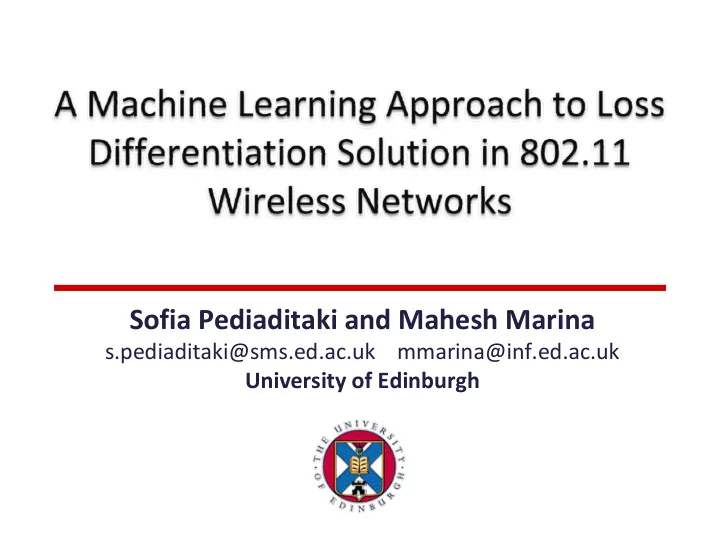

Sofia Pediaditaki and Mahesh Marina s.pediaditaki@sms.ed.ac.uk mmarina@inf.ed.ac.uk University of Edinburgh
Introduction � 802.11 Causes of Packet Losses: – Channel errors – Interference (collisions or hidden terminals) – Mobility, handoffs, queue overflows, etc. � How can a sender infer the actual cause of loss with: – No or little receiver feedback – A lot of uncertainty (time ‐ varying channels, interference, traffic patterns, etc.). � Use machine learning algorithms! 2
Do we Need Loss Differentiation? � Rate Adaptation: – Channel error Lower rate improves SNR – Collision Lower rate worsens problem � DCF mechanism: – In 802.11, cause of loss is collision by default – Doubling the contention window hurts performance if cause is channel error � Various other applications (e.g. Carrier sensing threshold adaptation [Ma et al – ICC’07]) 3
State of the Art Rate Adaptation Algorithms [CARA ‐ Infocom’06, RRAA ‐ MobiCom ’06] � Use RTS/CTS to infer cause of loss – Small frames resilient to channel errors – Medium is captured Data packet is lost due to channel error � Drawbacks – RTS/CTS is rarely used in practice – Extra overhead C – Hidden terminal issue not fully resolved – Potential unfairness A B D 4
Our Aim � A general purpose loss differentiator which is: – Accurate and efficient: � responsive and robust to the operational environment – Supported by commodity hardware � fully implementable in the device driver without e.g. MAC changes – Has acceptable computational cost and low overhead – Requires no (or little) information from the receiver 5
The Proposed Approach � Loss differentiation can be seen as a “ classification ” problem – Class labels : Types of losses – Features : Observable data – Goal : Assign each error to a class � The Classification Process: – Training Phase: � < attributes, class > pairs as training data – Operational Phase: � Classify new “unlabeled” data (test data) 6
The Classification Process < attributes, class > Training Phase Pre ‐ processing Input Dataset Training Data Learning Algorithm: Naive Bayes Bayesian Nets Decision Trees Etc. Operational Phase < attributes, ? > < attributes, class > “Unlabeled” Data Trained Model Prediction 7
Performance Evaluation (1/2) � Training data using Qualnet Simulator – Single ‐ hop random topologies (WLANs) � Varying number of rates and flows , with or without fading – Multi ‐ hop random topologies � One ‐ hop traffic, multiple rates, with or without fading � Learning algorithms using Weka workbench (University of Waikato, New Zealand) � Classes of interest: – Channel errors – Interference 8
Performance Evaluation (2/2) � Classification Features : – Rate � The higher the rate, the higher the channel error probability – Retransmissions No � Due to backoff, collision probability decreases across retransmissions – Channel Busy Time – Observed channel errors and collisions Easily obtained at the sender 9
Preliminary Results: No fading Try the simple things first (K.I.S.S. Rule)! Bayes Method Prediction Accuracy% Training Time (sec) Naive Bayes WLAN WLAN ‐ MH 0.01 99.5 95.9 � 29303 WLAN – 55140 WLAN ‐ MH instances � 10 ‐ fold Cross Validation � Almost perfect predictor ‐ But things are not that simple! 10
Preliminary Results: All together A small step for man ... Bayes Method Prediction Accuracy% Training Time (sec) Naive Bayes 87 0.06 Bayesian Net 87.7 0.15 � 125213 instances � 10 ‐ fold Cross Validation � Naive Bayes assumes attributes are independent � Bayesian Networks make Naive Bayes less “naive” 11
Discussion � Which machine learning algorithm is more appropriate to use? � Which features are the most representative? � Is this solution generalizable? � Can we use the solution as it is in real hardware? � How much training is it required? – What if we use semi ‐ supervised learning? 12
Summary � Why do we need a loss differentiator: – Rate adaptation algorithms, 802.11 DCF mechanism, ... � We propose a machine learning ‐ based predictor – Handles loss differentiation as “classification” problem � There are still many things do be we should consider... � So, can we use such solution? – Yes, we can [Obama ‘08] – Preliminary results show we could ☺ 13
Thank you Questions? 14
Recommend
More recommend